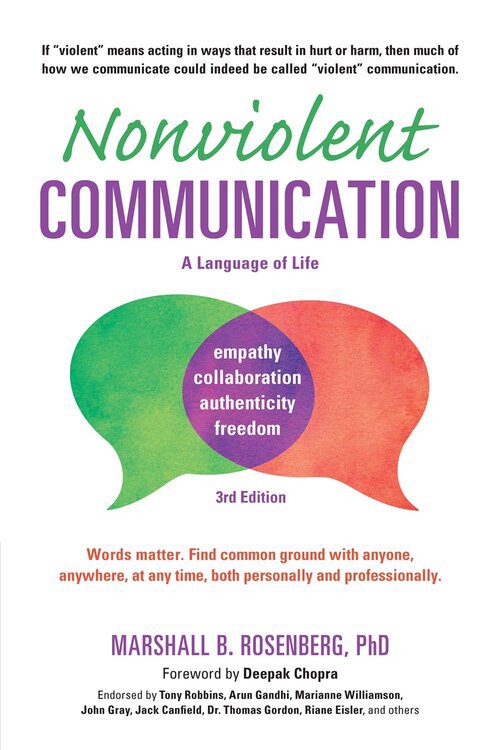Print | Kindle(eBook) | Audiobook
Nonviolent Communication (abbreviated NVC, also called Compassionate Communication or Collaborative Communication) is an approach to nonviolent living developed by Marshall Rosenberg beginning in the 1960s.
NVC is based on the assumption that all human beings have capacity for compassion and empathy and that people only resort to violence or behavior harmful to others when they do not recognize more effective strategies for meeting needs.
Nonviolent Communication: a way of communicating that leads us to give from the heart.
Here are my favourite take-aways from reading, Nonviolent Communication: A Language of Life: Life-Changing Tools for Healthy Relationships by Marshall Rosenberg:
Nonviolent Communication
- NVC guides us in reframing how we express ourselves and hear others. Instead of habitual, automatic reactions, our words become conscious responses based firmly on awareness of what we are perceiving, feeling, and wanting. We are led to express ourselves with honesty and clarity, while simultaneously paying others a respectful and empathic attention. In any exchange, we come to hear our own deeper needs and those of others.
- NVC trains us to observe carefully and to be able to specify behaviors and conditions that are affecting us. We learn to identify and clearly articulate what we are concretely wanting in any given situation. The form is simple, yet powerfully transformative.
The NVC Process
To arrive at a mutual desire to give from the heart, we focus the light of consciousness on four areas—referred to as the four components of the NVC model.
Four components of NVC:
1. observations
2. feelings
3. needs
4. requests
Observations
- The facts (what we are seeing, hearing, or touching) as distinct from our evaluation of meaning and significance. NVC discourages static generalizations. It is said that “When we combine observation with evaluation, others are apt to hear criticism and resist what we are saying.” Instead, a focus on observations specific to time and context is recommended
“When we combine observation with evaluation, people are apt to hear criticism.”
Feelings (emotions or sensations, free of thought and story.)
What others do may be the stimulus of our feelings, but not the cause
- These are to be distinguished from thoughts (e.g., “I feel I didn’t get a fair deal”) and from words colloquially used as feelings but which convey what we think we are (e.g., “inadequate”), how we think others are evaluating us (e.g., “unimportant”), or what we think others are doing to us (e.g., “misunderstood”, “ignored”).
- Feelings are said to reflect whether we are experiencing our needs as met or unmet. Identifying feelings is said to allow us to more easily connect with one another, and “Allowing ourselves to be vulnerable by expressing our feelings can help resolve conflicts.
People are disturbed not by things, but by the view they take of them.—Epictetus
Needs
- Universal human needs, as distinct from particular strategies for meeting needs. It is posited that “Everything we do is in service of our needs.
Requests (request for a specific action, free of demand.)
To tell if it’s a demand or a request, observe what the speaker does if the request is not complied with
- Requests are distinguished from demands in that one is open to hearing a response of “no” without this triggering an attempt to force the matter. If one makes a request and receives a “no” it is recommended not that one give up, but that one empathize with what is preventing the other person from saying “yes,” before deciding how to continue the conversation. It is recommended that requests use clear, positive, concrete action language.
“Requests may sound like demands when unaccompanied by the speaker’s feelings and needs.”
Requests versus Demands
- Our requests are received as demands when others believe they will be blamed or punished if they do not comply. When people hear a demand, they see only two options: submission or rebellion. Either way, the person requesting is perceived as coercive, and the listener’s capacity to respond compassionately to the request is diminished.
When the other person hears a demand from us, they see two options: to submit or to rebel.
- Requests are received as demands when listeners believe that they will be blamed or punished if they do not comply. We can help others trust that we are requesting, not demanding, by indicating our desire for them to comply only if they can do so willingly. The objective of NVC is not to change people and their behavior in order to get our way; it is to establish relationships based on honesty and empathy that will eventually fulfill everyone’s needs.
Two parts of NVC:
- Expressing honestly through the four components
- Receiving empathically through the four components
Moralistic vs Value Judgment
- “It is important here not to confuse value judgments and moralistic judgments. All of us make value judgments as to the qualities we value in life; for example, we might value honesty, freedom, or peace. Value judgments reflect our beliefs of how life can best be served. We make moralistic judgments of people and behaviors that fail to support our value judgments; for example, “Violence is bad. People who kill others are evil.”
Empathy
Empathy, requires us to focus full attention on the other person’s message. We give to others the time and space they need to express themselves fully and to feel understood.
“Holley Humphrey identified some common behaviors that prevent us from being sufficiently present to connect empathically with others. The following are examples:
- Advising: “I think you should … ” “How come you didn’t … ?”
- One-upping: “That’s nothing; wait’ll you hear what happened to me.”
- Educating: “This could turn into a very positive experience for you if you just … ”
- Consoling: “It wasn’t your fault; you did the best you could.”
- Story-telling: “That reminds me of the time … ”
- Shutting down: “Cheer up. Don’t feel so bad.”
- Sympathizing: “Oh, you poor thing … ”
- Interrogating: “When did this begin?”
- Explaining: “I would have called but … ”
- Correcting: “That’s not how it happened.”
“No matter what others say, we only hear what they are (1) observing, (2) feeling, (3) needing, and (4) requesting.”
When Pain Blocks Our Ability to Empathize
- It is impossible for us to give something to another if we don’t have it ourselves. Likewise, if we find ourselves unable or unwilling to empathize despite our efforts, it is usually a sign that we are too starved for empathy to be able to offer it to others. Sometimes, if we openly acknowledge that our own distress is preventing us from responding empathically, the other person may come through with the empathy we need.
“Translating Self-Judgments and Inner Demands
- When we communicate with ourselves on a regular basis through inner judgment, blame, and demand, it’s not surprising that our self-concept gives in to feeling more like a chair than a human being.
- A basic premise of NVC is that whenever we imply that someone is wrong or bad, what we are really saying is that he or she is not acting in harmony with our needs. If the person we are judging happens to be ourselves, what we are saying is, “I myself am not behaving in harmony with my own needs.” I am convinced that if we learn to evaluate ourselves in terms of whether and how well our needs are being fulfilled, we are much more likely to learn from the evaluation.
“When people are upset, they often need empathy before they can hear what is being said to them.”
Four Steps to Expressing Anger
1. Stop. Breathe.
2. Identify our judgmental thoughts.
3. Connect with our needs.
4. Express our feelings and unmet needs.
People do not hear our pain when they believe they are at fault.
All the best in your quest to get better. Don’t Settle: Live with Passion.



1 Comment
Pingback: 100 Books Reading Challenge 2020 – Lanre Dahunsi